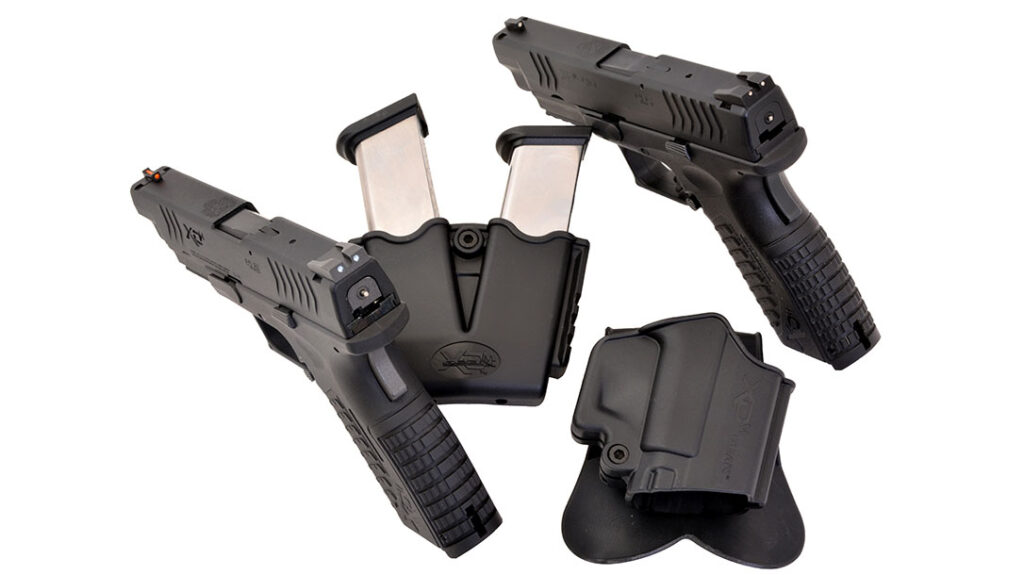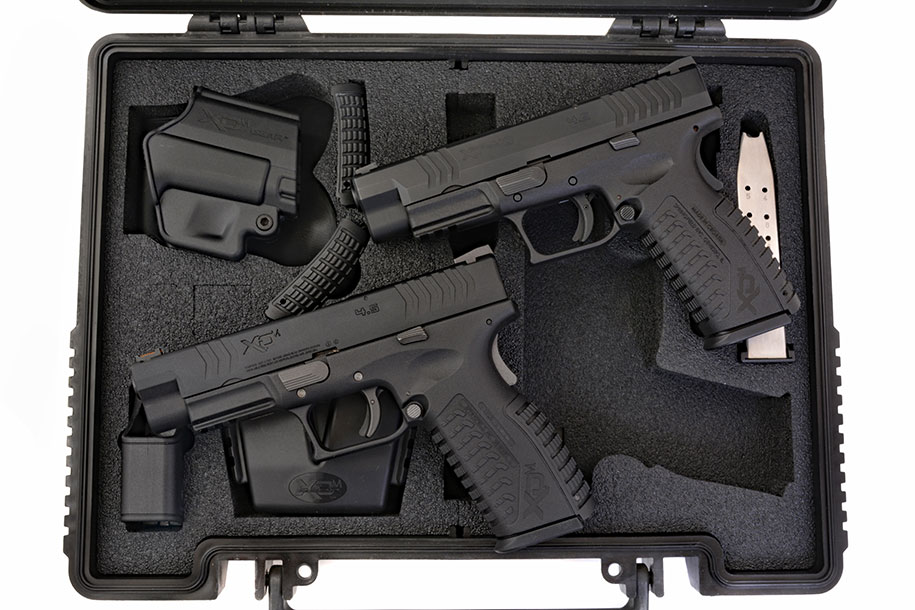Working with blowback-action CO2 pistols can offer a realistic training scenario against the same targets used with live ammo. And airguns that are 1:1 with their centerfire counterparts also allow the use of standard duty gear and accessories for a full training experience. This is where the Air Venturi Springfield Armory XD-M 4.5 CO2 comes in.
The Air Venturi Springfield Armory XD-M 4.5 CO2
For absolute equality, there was nothing as perfectly matched in handling and operation as the Umarex Glock 17 CO2 model. This is even though it cannot be field-stripped like the centerfire model.
Today, I submit for your consideration a blowback-action air pistol that has drawn a line in the sand between authentic-looking CO2 training guns and centerfire guns—the Air Venturi Springfield Armory XD-M 4.5 semi-auto pistol.
Advertisement — Continue Reading Below
Twinning
No CO2 pistol, thus far, has been so thoroughly matched to its centerfire counterpart as the Springfield XD-M 4.5 CO2. Specifically for design detail, fit, and finish.
S&W, Glock, and Heckler & Koch worked very closely with Umarex, and Sig Sauer with its own airgun division. Likewise, Air Venturi and Springfield Armory worked perhaps even closer to get this CO2 model right in every essential detail. This includes its ability to be field-stripped exactly like the centerfire gun.
Externally, there are no obvious tells, no subtle hints or safety warnings, and no .177 caliber markings. Except on the barrel lug exposed in the ejection port, where every Springfield Armory model has its caliber stamped. The gun looks as close as physically possible.
Advertisement — Continue Reading Below
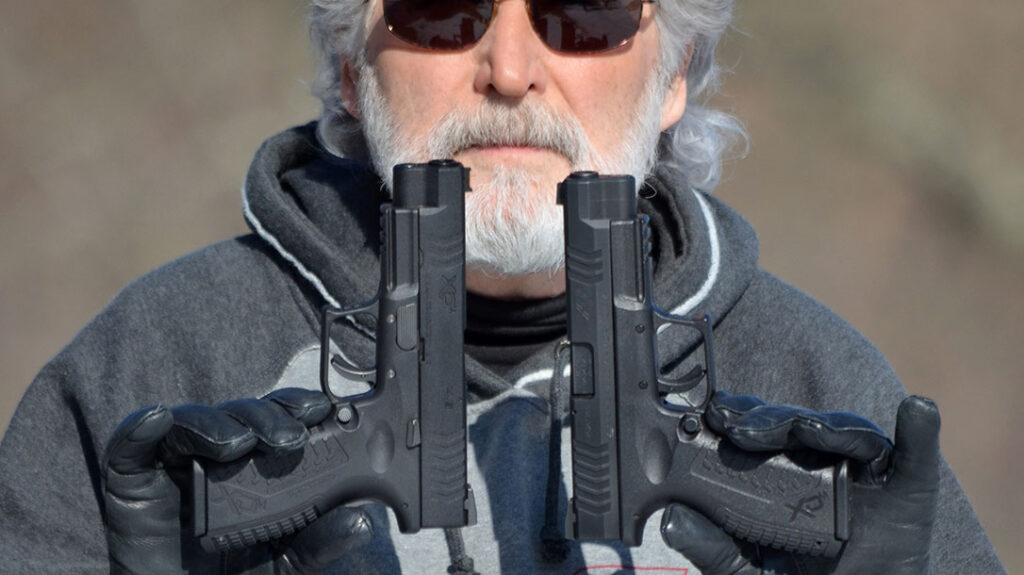
Even the one concession to air pistol manufacturing, the addition of a secondary manual safety mandated when the centerfire gun uses a Glock-style blade trigger safety, has been built into the actual serial number plate under the dustcover.
It looks like every other XD-M serial number plate. With the exception that it slides in the channel to put the gun on SAFE. Even the centerfire model’s cocked action indicator at the slide’s rear is duplicated and works on the CO2 pistol.
Advertisement — Continue Reading Below
Nothing has been overlooked. It is almost entirely indistinguishable from the centerfire models. That is unless you are looking down the barrel and can see the smaller, recessed muzzle.
There is no simple way to tell that this is not an XD-M 4.5. No blowback-action CO2 model made thus far demands a greater sense of responsibility to treating it like an actual centerfire handgun than the new Springfield model.
Centerfire Guns
Understanding the design of the 9mm, .40 S&W and .45 ACP versions is the key to understanding the CO2 pistols. In purpose, they are one and the same.
Advertisement — Continue Reading Below
In one of my early reviews of the 9mm XD-M for Combat Handguns, I wrote that “…wrapping your hand around an XD-M is like grabbing the shifter on a high-performance sports car; there’s a lot of horsepower here.
“The hi-capacity XD-M models have match-grade barrels, long, leggy grips, and modest carry weights with superbly crafted polymer frames. It’s no lightweight when it comes to taking up recoil. An XD-M is nevertheless a full quarter-pound less on the hip than a comparable Springfield Model 1911-A1, and that’s a gun with almost half the capacity of the XD-M.”
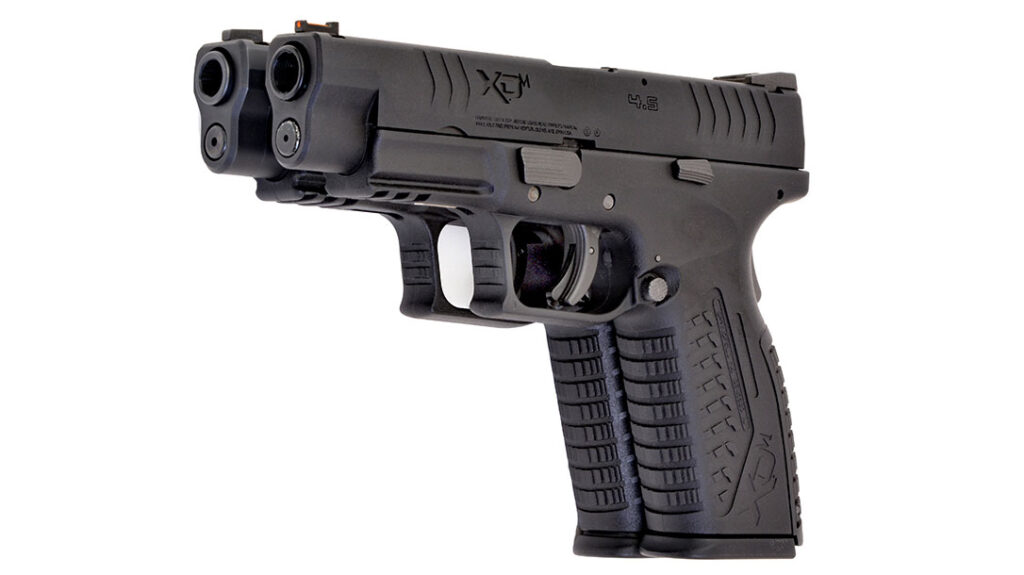
Advertisement — Continue Reading Below
With Springfield Armory’s long history of building 1911 models, there is a touch of 1911 in every XD-M. Not only because of the gun’s very familiar feeling grip angle, but Springfield’s adaptation of a 1911-style grip safety. This is combined with a pivoting trigger safety (similar to a Glock), creating the XD-M’s unique dual safety system that is almost unrivaled in the handgun industry.
Both must be depressed in order to discharge the firearm. There is no external safety to click on or off, no de-cocker. As a carry gun, cocked-and-locked is the XD-M’s normal safe condition. The CO2 model duplicates this.
XD-M Design Factors
The XD-M design (9mm, .40 S&W and .45 ACP) has two indicators that show when a round is chambered and if the action has been cycled. Both are easily seen, even in low-light conditions or in the dark, distinguished by touch.
Advertisement — Continue Reading Below
The loaded chamber indicator is located behind the ejector port on top of the frame. It’s front edge projects upward just enough to see it. Likewise, you can surreptitiously feel it if you run a finger over the top of the slide. On the CO2 model, it is always in the chambered round position, slightly raised above the top of the slide.
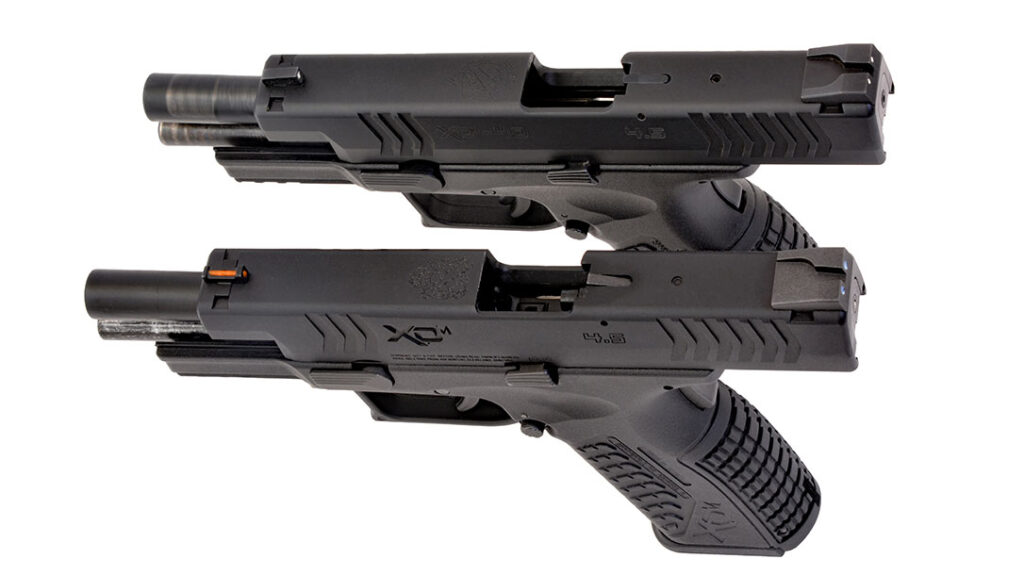
The cocking indicator takes a page from guns like the Walther P99. Specifically, the back of the striker protrudes through the rear face of the slide when the action has been cycled.
Advertisement — Continue Reading Below
This, however, does not mean that a round is chambered with the centerfire pistols. That is where the loaded chamber indicator becomes essential. Back in the old days, one would do a press check to make sure a round was chambered. You would push the slide back just far enough to see the shell case.
While the centerfire XD-M is a striker-fired gun, the CO2 model uses a small internal hammer as a striker. It has a separately activated striker pin to protrude from the back of the slide when it has been cycled and the action is ready to fire. This is as close to the actual XD-M as physically possible for an air pistol.
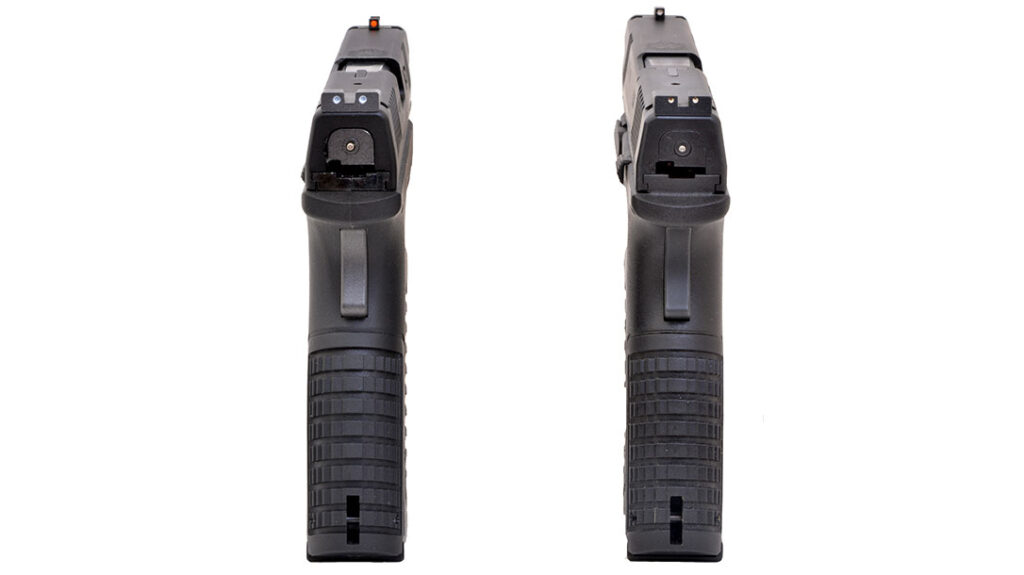
Advertisement — Continue Reading Below
Built-In Features
The built-in features of the centerfire XD-M series cover more ground than some custom-built semi-autos. The guns have tapered ambidextrous magazine releases, ambidextrous indexing thumb rests, deeply angled front and rear slide serrations, and come with two interchangeable backstrap panels.
Standard sights are red fiber-optic with low light Tritium sights optional. The CO2 model comes with the red fiber-optic. Both front and rear sights on the CO2 model dovetail in and lock in place with set screws from underneath. Though not adjustable, they are removable.
Then, there is the ease with which the XD-M fieldstrips. Remove the magazine, clear the chamber, lock the slide back, and rotate the takedown lever upward. It’s the large lever a third of the way back on the left side of the frame.
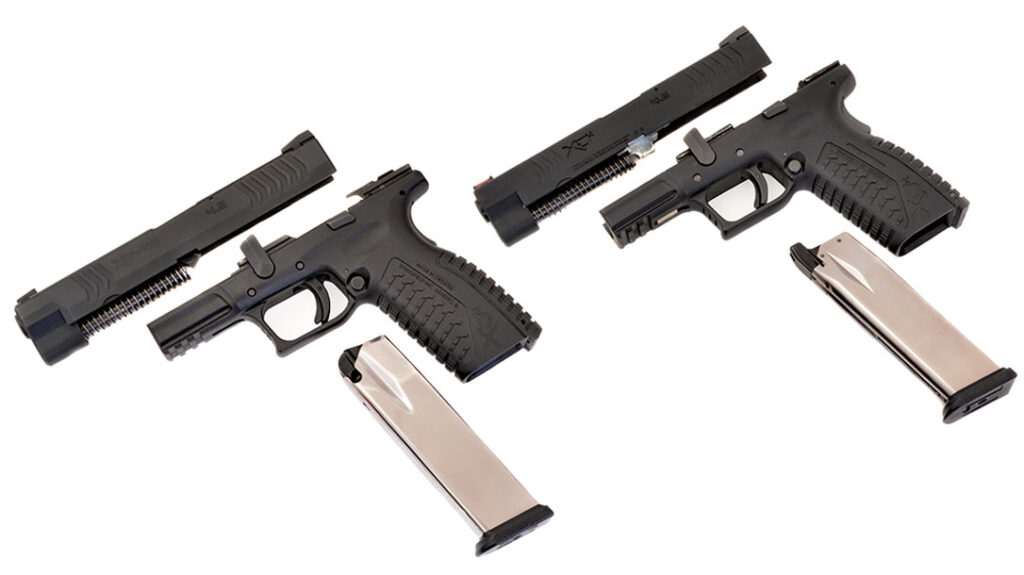
Then, pull the slide back until it disengages from the slide lock, and pull the slide forward off the frame. The recoil spring and guide rod lift for removal. Just lift the barrel slightly and remove it.
Reassembly is just as quick. The CO2 model fieldstrips exactly the same. Training with air can be 100-percent accurate in every aspect right up to the moment you pull the trigger. And even then, with the XD-M 4.5’s fairly robust slide recoil (powered by CO2), you have a modest kick.
Preparing to Fire the CO2
Loading CO2 into the XD-M-style polished steel magazine is a two-step process. With the magazine inverted and the loading channel facing you, pull the tab at the bottom of the channel down. This is locked into a small slot in the base pad.
Slide the base pad forward and remove it. This exposes the seating screw. Unscrew it, insert the CO2 cartridge (with a small drop of Pellgun Oil on the tip), replace the seating screw, and tighten it down. Then, replace the base pad and make certain the tab is engaged in the slot.
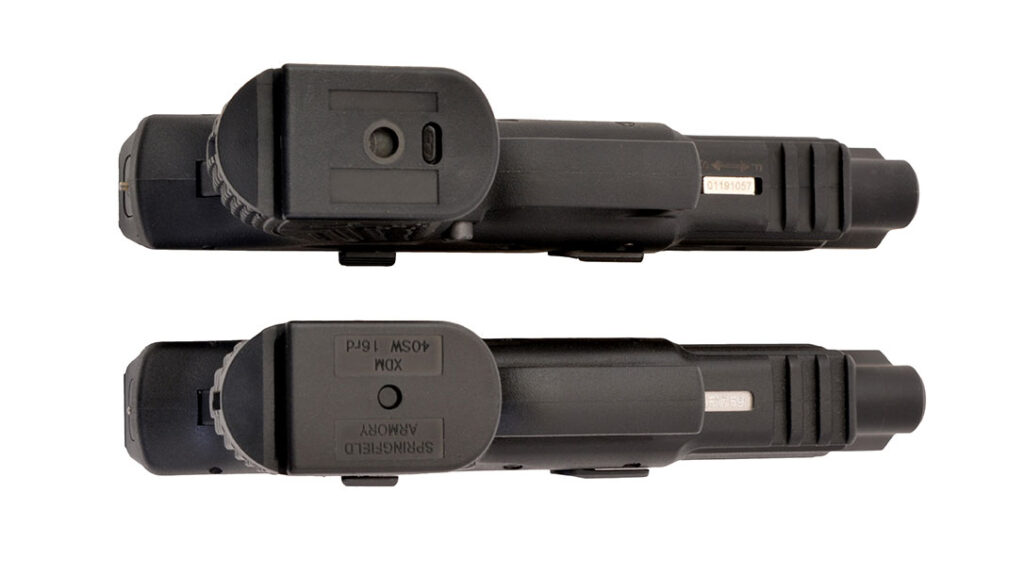
Loading the 20 BBs into the magazine (equivalent to the 9mm model with 19 rounds plus one chambered) is also a little different and better than other CO2 designs.
The pistol comes with a magazine follower loading assist tool. This allows you to pull the follower down and hold it while inserting BBs into the large loading channel. The BBs stagger just like cartridges in the centerfire magazines.
Shooting the XD-M 4.5 CO2
The average velocity clocked 300 fps, and the gun shot slightly low but well centered for windage. My initial 10-round target, shot while I was chronographing the gun at 21 feet, measured 1.3 inches center-to-center. The best five-shot group measured 0.875 inches.
Eight of the 10 were solidly in the red, with two cutting into the black at 6 o’clock. The gun shot 2 inches below point-of-aim, so my correction was 12 o’clock at the top of the 9 ring.
I went back and shot a 10-meter pistol target with Umarex steel BBs. My best 10-shot group measured 1.09 inches, with a best five-shot group at 0.685 inches. I had corrected my point-of-aim up to the 5 ring at 12 o’clock, and shots actually came in a bit high but nicely centered.
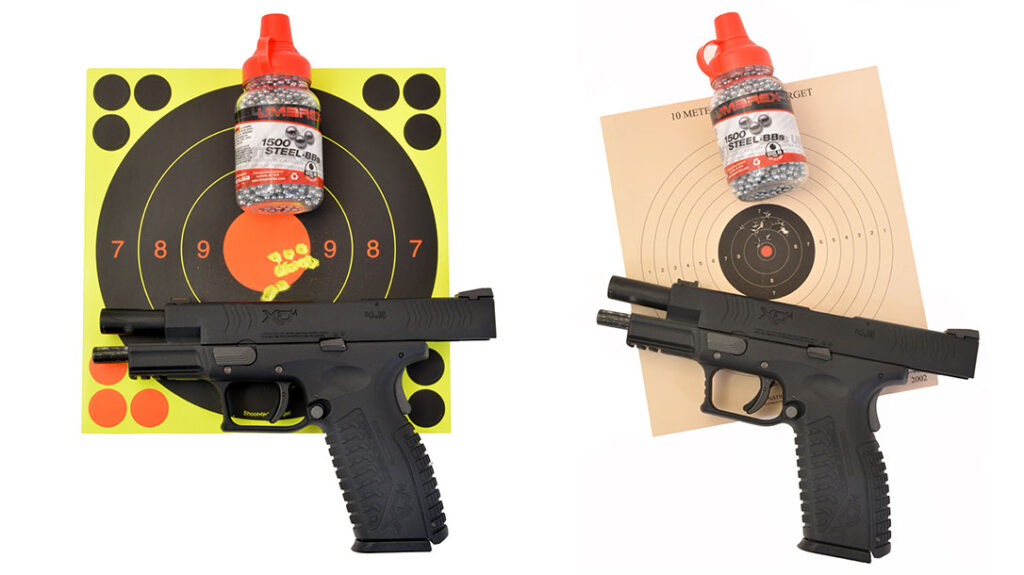
You have to remember that the XD-M CO2 model is not a target pistol with fixed sights. But my groups with the CO2 pistol are commensurate with the centerfire XD-M 4.5 shot from 50 feet.
The Potential of the Springfield XD-M 4.5 CO2
In terms of potential, the XD-M has a great deal of promise. Both as an excellent recreational shooting pistol and as the most accurate to the centerfire model training gun thus far. And that is something we pay for as much as accuracy in an air pistol.
If you are a Springfield Armory XD fan, this CO2 version is a must-have model!
Editor’s Note: The particular Springfield XD-M 4.5 featured here is no longer produced, but it is available in secondary markets. Do check out Springfield-Armory.com for the growing number of XD series variants available today.
For more information on the XD-M 4.5 CO2 , please visit AirVenturi.com.
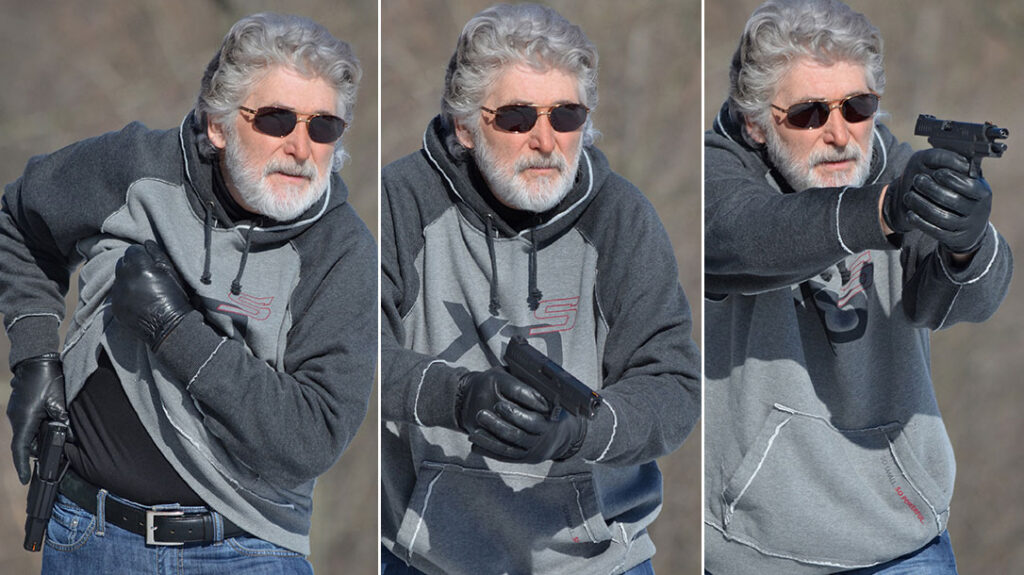
Springfield XD-M 4.5 Specs
Caliber: 9mm
Barrel: 4.5 inches
Overall Length: 7.75 inches
Weight: 29 ounces (empty)
Grips: Polymer
Sights: Low-profile white dot rear, white dot or red fiber-optic front
Action: Striker-fired
Finish: Black
Capacity:19+1
MSRP: N/A
Springfield XD-M 4.5 CO2 Specs
Caliber: .177
Barrel: 4 inches
Overall Length: 7.75 inches
Weight: 31 ounces (empty)
Grips: Polymer
Sights: White dot rear, red fiber-optic front
Action: Blowback, short-recoil, internal hammer-fired
Finish: Black
Capacity:20
MSRP: $120
This article was originally published in the Combat Handguns September/October 2022 issue. Subscription is available in print and digital editions at OutdoorGroupStore.com. Or call 1-800-284-5668, or email subscriptions@athlonmediagroup.com.
